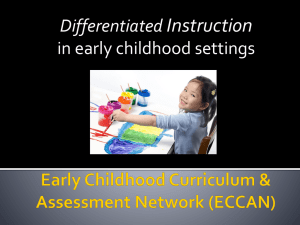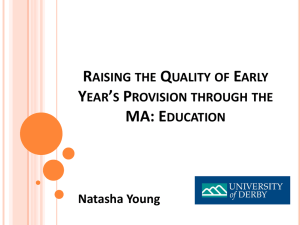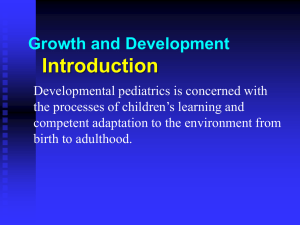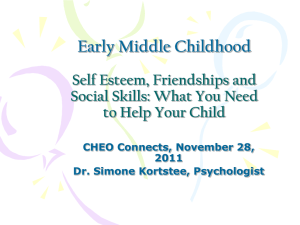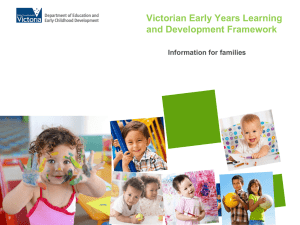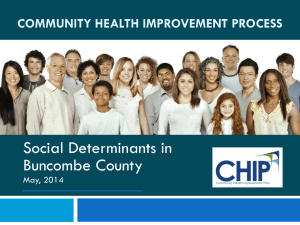Dr. Joan Lombardi`s Early Childhood presentation
advertisement
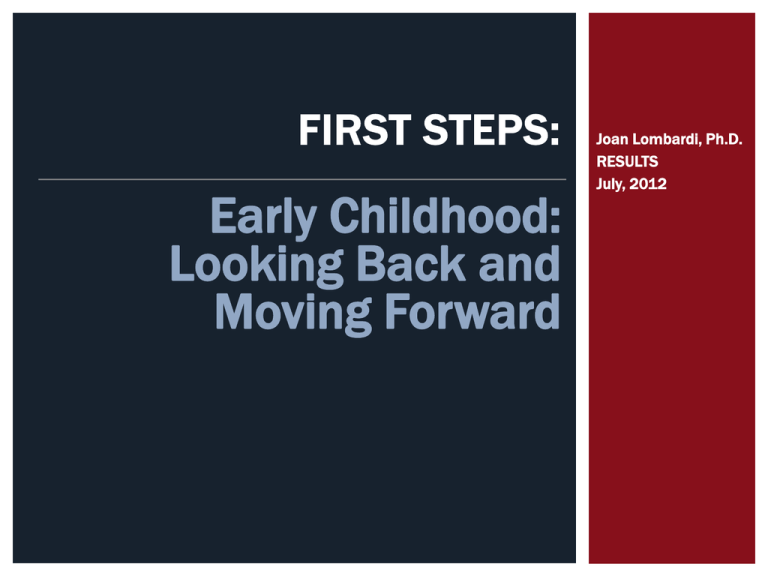
FIRST STEPS: Early Childhood: Looking Back and Moving Forward Joan Lombardi, Ph.D. RESULTS July, 2012 Progress Challenges Towards a National Strategy Reflecting on history……. 1909 First White House Conference on the Care of Dependent Children 1912 The Establishment of the Children’s Bureau 1935 Title V Maternal and Child Health 1965 Head Star t 1970’S -2008 The Child Care and Development Fund The Children’s Health Insurance The Education Goals Early Head Start State Prek Initiatives EARLY CHILDHOOD MATTERS… THE CASE IS STRONG, THE SCIENTIFIC EVIDENCE CONVERGES Neuroscience Molecular biology Genomics Developmental psychology Epidemiology Sociology Economics Relationships Matters, Health Matters ADVERSE CHILDHOOD EXPERIENCES AND ADULT CARDIOVASCULAR DISEASE 3.5 Odds Ratio 3 2.5 2 1.5 1 0.5 0 1 2 3 4 5,6 7,8 ACEs Source: Dong et al, 2004 New appreciation for the integrated nature of early childhood development Early Learning Health, Nutrition and Mental Health Family Support and Child Protection New Vision Old Think • • • • • Learning begins at school Health or education Care vs education Child focus vs parent focus Transition from preschool to school New Think • • • • • Learning begins at birth Health and education Care and education Two generations Continuity prenatal- 8 MORE RECENT RESOURCES Early Childhood Funding in the American Recovery and Reinvestment Act The Maternal, Infant and Early Childhood Home Visiting Program The Early Learning Challenge CHALLENGES Inequality Funding The policy environment The capacity of the field VARIATION BY STATE: ALL CHILDREN VARIATION BY STATE: CHILDREN UNDER SIX DISPARITIES ON THE BAYLEY COGNITIVE ASSESSMENT BET WEEN HIGHER AND LOWER INCOME INFANTS AT 9 AND 24 MONTHS Source: Halle, T., Forry, N., Hair, E., Perper, K., Wandner, L., Wessel, J., & Vick, J. (2009). Disparities in Early Learning and Development: Lessons from the Early Childhood Longitudinal Study – Birth Cohort (ECLS-B). Washington, DC: Child Trends. SCHOOL READINESS BY MOTHER’S EDUCATION LEVEL Percent Percentage of First-time Kindergartners Demonstrating Positive Indicators of School Readiness by Mother’s Education Level, 1998 Source: Child Trends and Center for Health Research. (2004). Early Child Development in Social Context. Data from K. Denton, E. Germino-Hausken, and J. West (project officer), America’s Kindergartners, NCES 2000-070, (Washington, DC: U.S. Department of Education. National Center for Education Statistics, 2000). Child Well Being in Rich Countries UNICEF Innocenti Research Center, Report Card 7, 2007 THE FACTS ABOUT CHILD CARE IN THE UNITED STATES Nearly 11 million children under age 5 spend time in some type of child care arrangement every week On average the children of working mothers spend 35 hours a week in child care Child care expenses take a significant bite out of family income, particularly for low income families Child Care Aware of America, 2012 TIGHTENING RESOURCES Only 1 out of 6 eligible families are able to access child care assistance Head Start serves less than half the eligible children Early Head Start serves less than 5 percent of the eligible children QUALIT Y AND ACCESS THREATENED Eligibility Rates Co-payments Salaries Other quality improvements LACK OF CHILD CARE SUPPORT EFFECTS FAMILIES Much of the progress made under ARRA in child care has stalled Families in 37 states were worse off in 2011 than in 2010 due to one or more changes in state child care assistance policies such as more restrictive eligibility criteria, longer waiting lists, higher co-payments or lower provider reimbursement rates (National Women’s Law Center) QUALITY AND DURATION MATTER ( M ON TH S OF DE VE LOP MENTAL A DVA NTAG E ON LI T E RAC Y) 8 7 6 5 low quality average high quality 4 3 2 1 0 1-2 years 2-3 years Source: E Melish, EPPE Study CURRENT POLICY ENVIRONMENT Gap between what science says and what policies support Complex policy environment Difficult to describe and navigate Policies not aligned Multiple human needs Slow policy process THE CAPACIT Y OF THE FIELD There are an estimated 2. 2 million individuals who are paid members of the early childhood workforce. They make up 30 % of the instructional workforce. Estimated 3.2 million individuals provide non paid non parental care Women working in early care earn 31% less than women with similar qualifications in other fields Continued difficulty attracting and retaining staff Higher education institutions do not have capacity to respond to the diversity of roles and amount of preparation needed to assure high quality Wo r k f o r c e e s t i m a te s by R i c k B r a n d o n , i n T h e E a r l y C h i l d h o o d C a r e a n d E d u c a t i o n Wo r k f o r c e : C h a l l e n g e s a n d O p p o r t u n i t i e s , I n s t i t u te o f M e d i c i n e a n d N a t i o n a l R e s e a r c h C o u n c i l , 2 01 2 Towards a National Strategy DEVELOPING A NATIONAL PLAN FOR UPCOMING REAUTHORIZATIONS The Child Care and Development Fund Head Start Elementary and Secondary Education LAUNCHING A CAMPAIGN TO SUPPORT THE ECONOMY THROUGH IMPROVED EARLY CHILDHOOD JOBS Build public awareness about the importance of the work and the contribution to the economy Include early childhood in any job creation measures Target funding to improve the capacity of higher education institutions Create community infrastructure/networks to support early childhood providers CREATING NEW VOICES AND UNITING THE GENERATIONS ( S O U R C E : G E N E R AT I O N S U N I T E D Supporting a new generation of leaders And thinking Across Borders….. THE LANCET ON CHILD DEVELOPMENT 2007, 2011 200 million young children are at developmental risk due to poverty, malnutrition, lack of early stimulation and other factors There is growing evidence from countries in the global south that we can intervene early and make a difference Children in the poorest households are less likely than children in the richest household to access early childhood education programmes Percentage of children aged 36-59 months that attend some form of early childhood education programme, by household wealth, in the 36 countries where there was a statistically significant difference 100 Poorest 20% Richest 20% 90 80 70 60 50 40 30 20 10 0 Note: This analysis included 36 countries ***p ≤ .01 (statistically significant at the 1% level) Source: MICS3, UNICEF Average Preschool enrolment by region and income –less than 20% for poorer income quintiles Keep moving forward!


